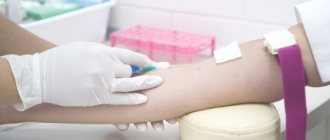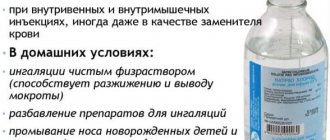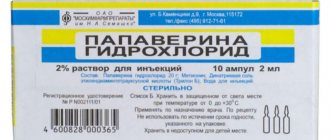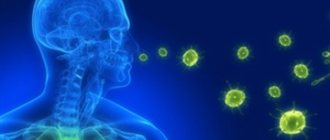In case of heart problems, a polarizing mixture allows you to replenish the disturbed volumes of potassium in the body. Cardiologists prescribe droppers with it to their patients. The product's composition of 4 components affects the heart muscle and protects it from heart attacks.
Polarizing agent:
- has a changing composition;
- regenerates electrolyte balance in the myocardium;
- reduces the area of necrosis during a heart attack;
- stabilizes the rhythm of contractions;
- weakens the effects of ischemia.
What is a polarizing mixture
A rapid-acting drip medicine, a polarizing mixture, is used for the treatment of complex heart diseases. The product is prepared in pharmacies of therapeutic departments according to medical prescriptions. The basis of the drug is 5 or 10% glucose. When creating a solution for a dropper, it is combined with other components.
Additions to glucose in the polarizing mixture can be:
- panangin;
- asparkam;
- potassium chloride.
The polarizing agent is administered through the system, intravenously. Such a mixture may include various components. Its composition depends on the individual characteristics of the body. Droppers with a similar drug are most popular in cardiology.
Short-acting insulin is designed to neutralize the strong glucose load in the product. Its quantity is determined by the content and concentration of sugar in the preparation. Additionally, but not necessarily, magnesium may also be present in the polarizing mixture.
Insulin allows all components to penetrate into the cellular space. Glucose keeps cells energized. Magnesium strengthens the nervous system, and potassium easily generates operating potential.
Active ingredients of the drug
The mixture in its original form contains:
The composition of the polarizing mixture varies depending on the proportions and type. Some products (varieties of solution) contain a minimal amount of potassium chloride, insulin and glucose solution. In other versions, the medicine contains several grams of potassium chloride, insulin, and a weakly concentrated glucose solution. As you can see, the compositions are similar; they are used to restore heart function. A mixture is produced in which potassium chloride is replaced by Panangin.
Composition of the dropper
The following table shows that there are several approximate compositions for creating polarizing solutions:
| Number and approximate name of the composition | Potassium chloride content (g) | Insulin content (units) | Glucose content (ml) |
| Classical | 2 | 6 | 350%) |
| Concentrated | 4 | 8 | 2500%) |
| With component replacement | Panangin (magnesium sulfate) – 80 ml | 8 | 150 (10%) |
The polarizing composition of the droppers promotes saturation with electrolytes, which the body loses under certain circumstances.
Potassium deficiency, for example, results from:
- coma with diabetes mellitus;
- postoperative periods;
- long-term use of corticosteroids or diuretics;
- significant electrolyte loss with diarrhea or vomiting;
- kidney damage;
- cirrhosis of the liver.
Hypokalemia manifests itself clinically:
- intestinal paresis;
- nausea;
- vomiting;
- muscle weakness;
- depression;
- cardiovascular disorders.
Macronutrient potassium in the body:
- maintains homeostasis;
- stimulates biological cellular activity;
- regulates neuromuscular conduction and excitability.
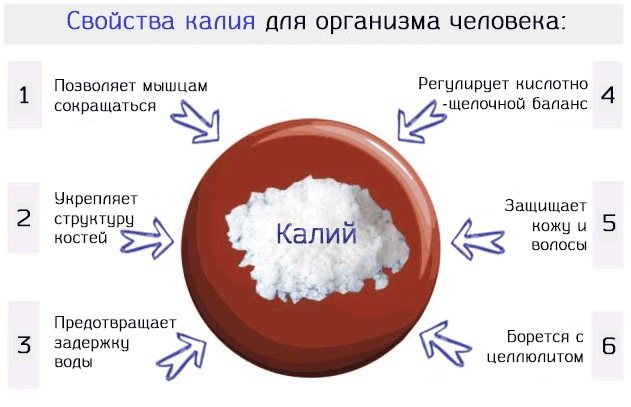
A polarizing mixture (the composition of the dropper controls the amount of sodium and calcium in the cells) helps to weaken the excitability of the myocardium. This magnesium drug lowers blood pressure and inhibits the circulation of abnormal impulses during arrhythmia. At the same time, internal metabolic processes also improve.
The properties of magnesium are attributed to:
- regulation of physiological and biochemical reactions;
- beneficial effects on the central nervous system and myocardial cells;
- participation in the regulation of electrolyte balance within cells;
- stabilization of vascular tone;
- preventing electrical cellular instability;
- inhibition of blood clot formation;
- decreased blood pressure;
- weakening of arterial spasms;
- muscle relaxation;
- increased urination.
Causes of magnesium deficiency include:
- treatment with diuretics;
- diarrhea or vomiting;
- ulcerative colitis;
- starvation;
- alcoholism;
- stress;
- endocrine disorders;
- pregnancy.
With hypomagnesemia the following are observed:
- obstetric complications;
- convulsions;
- depression or anxiety;
- dizziness;
- vomit;
- diarrhea;
- nausea;
- adverse effects from the heart and blood vessels;
- bronchospasm.
The principle of influence on the body
Components included in the complex therapeutic mixture:
- allow substances to freely penetrate into cells (insulin)
- support the energy of molecules (glucose);
- strengthen the nervous system (magnesium);
- facilitate the generation of effective potential (potassium).
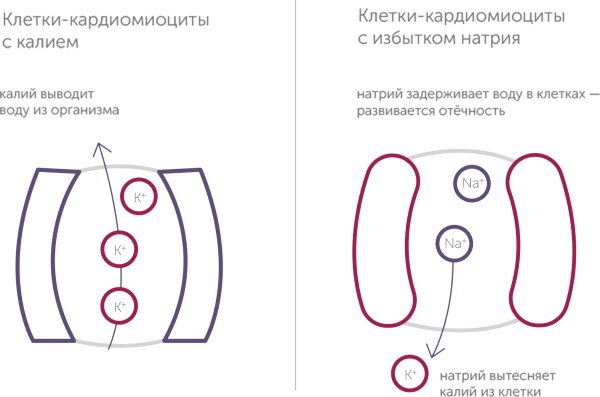
Polarizing droppers have long been recognized by doctors. Complex compositions have gained confidence due to their positive effects on heart attacks. Such mixtures normalize heart rhythm by stabilizing disturbed metabolism. At the same time, the volume of potassium lost during illness is replenished.
Panangin or magnesium sulfate solution, if included in the polarizing mixture, supports the cardioprotective effect of the drug.
It also has the following characteristics:
- preventing blood clots;
- decreased blood pressure;
- weakening of arterial spasms;
- muscle relaxation;
- increased urination.
A polarizing mixture (the composition of the dropper has restorative and protective effects) is indicated for serious heart problems. Doctors also prescribe this remedy to those who have a deficiency of magnesium and potassium in their blood. The drug stabilizes the rhythm and has a beneficial effect on the heart.
When potassium accumulates inside the body under the influence of glucose and insulin, muscle cells become more polar and also respond more easily to excitatory signals.
With an overdose of potassium, which occurs after the rapid introduction of a polarizing mixture through the system, side effects may occur such as:
- allergy;
- acidosis;
- hyperkalemia;
- paralysis;
- fatigue;
- muscle weakness;
- paresthesia and convulsions;
- heaviness in the arms or legs;
- confusion;
- heart failure;
- bradycardia;
- arrhythmia;
- nausea.
Signs of potassium overdose are:
- slow heart rate;
- ECG changes;
- fatal hyperkalemia.
Potassium becomes toxic to patients with impaired adrenal function. Patients with traumatic brain injuries or slow conduction of cardiac impulses during therapy with polarizing droppers should be constantly monitored by a physician. The composition of the systems must be administered as slowly as possible so as not to lose the patient from severe hyperkalemia.
Non-depolarizing muscle relaxants
The group of compounds is mistakenly referred to as drugs related to polar. However, the range of diseases for which they are used is far from cardiac diseases. It is advisable to use these funds in neurological practice.
The polarizing mixture is effective for heart pathologies due to its complex action. It is advisable to use the solution in cases of metabolic disorders. Independent use is unacceptable, as it requires monitoring potassium levels and recording electrocardiography.
Noticed a mistake? Select it and press Ctrl+Enter to let us know.
Source
Indications for use
A polarizing electrolyte solution works best when:
- joint therapy with antihypertensive and diuretic drugs;
- vomiting and prolonged diarrhea;
- complex poisonings;
- intoxication with cardiac glycosides;
- coronary heart disease;
- arrhythmias;
- extensive necrosis;
- abnormal heart rhythm;
- ventricular tachycardia;
- progressive myocardial infarction;
- acute coronary syndrome;
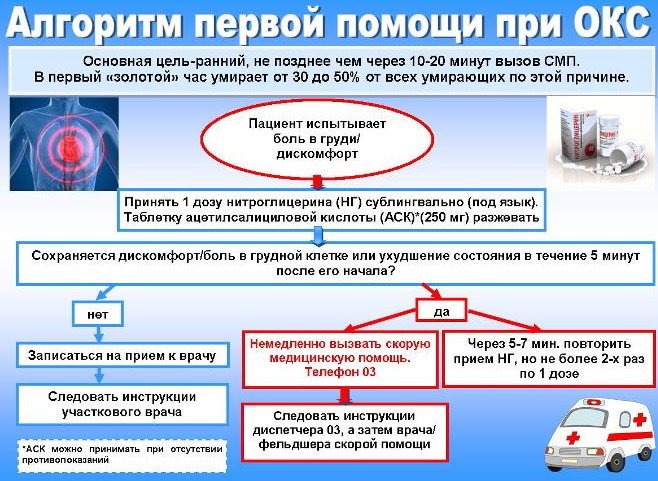
- heart failure.
The polarizing mixture, the composition of the dropper may vary, is prepared based on the results of biochemical and electrolyte blood tests. The drug solution is intended for intravenous administration. Its remains are not stored, but disposed of immediately. The electrolyte compound is not prescribed to adolescents under 18 years of age or to pregnant women.
A complex mixture of electrolytes and insulin is prescribed for patients with acute heart attack. Therapy with polarizing droppers increases the readings of potassium and glucose in the blood from the first use. The treatment is individualized, taking into account all the dangers and instructions. If there is obvious benefit for the patient, the specialist applies the remedy, controlling the condition of the disease.
Active polarizing therapy is suitable for replenishing the heart with electrolytes and glucose. Its main 3 components can be supplemented with panangin or magnesium in ampoules. Such polarizing mixtures differ in proportions and are used to get rid of electrolyte deficiency. They are also prescribed for the complex treatment of rhythm disorders and glycoside intoxications.
The effect of droppers with a polarizing composition is due to increased metabolism and potassium levels in cardiomycytes. When there is a lack of oxygen, the electrolyte quickly penetrates the cells. Under the influence of glucose and insulin, it accumulates in them, due to which the response to stimulating factors and polarity is stabilized.
Therapy with polarizing compounds:
- heals damage to heart tissue caused by ischemia;
- weakens necrosis;
- reanimates heart rhythm;
- restores the condition of patients with heart failure.
If magnesium and potassium levels in the blood are normal, polarizing droppers are replaced with cordarone or lidocaine. These drugs are more effective and do not cause excess electrolytes. During the day, use 200-400 ml of the polarizing mixture. This norm is recommended by cardiologists. It is administered by drip, intravenously.
When potassium levels in the bloodstream increase to 7 mmol per liter, the following occurs:
- heartbeat disturbance;
- muscle weakness;
- weakening of the pulse;
- rapid breathing;
- thirst;
- fainting;
- heavy urination;
- numbness of legs and arms;
- mental disorders;
- stomach pain;
- decrease in blood pressure.
If such side effects appear, then treatment with polarizing agents is stopped. Instead, sodium chloride and diuretics are prescribed to quickly get rid of potassium in the blood.
When prescribing therapy with a polarizing mixture, cardiologists and neurologists must monitor patients with traumatic brain injuries and slow conduction of impulses to the heart. Vials with electrolytes are used once. Reuse of their content is not permitted. During course therapy, constant monitoring of ECG indicators and blood glucose levels is performed.
The rapid introduction of droppers with polarizing contents is strictly prohibited, as this always leads to death. The composition of a complex treatment mixture is variable. It is prescribed taking into account information about the examination of the patient. Only with this approach can undesirable effects from the use of a polarizing composition be eliminated. It is known that intensive therapy with such mixtures decompensates the condition of the myocardium and is very harmful for patients.
The polarizing mixture (the composition of the dropper and its purpose are inextricably linked) is suitable for the treatment of neurological and cardiac pathologies. The multicomponent solution helps stabilize the heart rate and prevents the development of heart attacks. At the same time, the components of the drug relieve myasthenia gravis.
Contraindications for use
Contraindications to the use of a polarizing agent are:
- presence of severe burns;
- excess or sufficient amount of electrolytes in the blood:
- intestinal obstruction;
- diabetes;
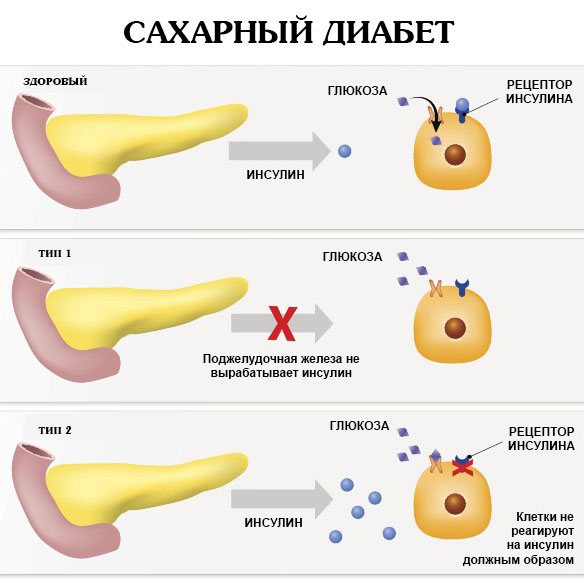
- cerebral edema;
- impulse blockade phenomena in the myocardium;
- renal failure;
- deficiency of sodium volume and blood circulation;
- acidosis or oxidation of the blood.
In case of intoxication with a polarizing mixture, the following may be observed:
- pulse and heart rhythm disturbances;
- muscle weakness;
- strong need to drink;
- fainting;
- excessive urination;
- numbness of hands and feet;
- mental disorders;
- stomach pain;
- hypotension.
A polarizing agent is not prescribed:
- teenagers under 18 years of age;
- pregnant women;
- during the lactation period.
Directions for use and doses
In cardiology, patients are administered a polarizing mixture once a day.

Droppers with it should contain:
- insulin (8 units);
- 10% glucose (250 ml);
- potassium chloride (40 g).
A complex mixture has the following qualities:
- reduces the risk of death by 12%;
- improves blood circulation;
- changes the state of electrolyte balance;
- corrects heart rate.
Along with the polarizing mixture, angina pectoris is treated with:
- Antianginal drugs that reduce the heart's need for oxygen and promote the growth of oxygen molecules in the blood. Such means include:
- beta blockers, which prevent the development of ischemia;
- calcium antagonists;
- nitrates.
- Antiplatelet agents that thin the blood.
- Statins.
- Diuretics.
- Cardiac glycosides.
When treating neurological disorders, the amount of potassium in the blood is controlled using a polarizing mixture. If it suddenly increases, then this component is removed from the product or its dose is adjusted.
Along with the described control, the following is also monitored:
- clinical condition of the patient;
- acid-base balance;
- ECG;
- electrolytes.
All these actions are carried out for the timely recognition of hyperkalemia, which appears quickly and asymptomatically. From an overabundance of the element in the body, heart block develops inside, and death can even occur.
In neurology, instead of the described complex mixture for droppers, treatment with non-depolarizing muscle relaxants is often used. These drugs regulate the production of histamine and affect the autonomic nervous system.
These included:
- arduan;
- nimbex;
- tracrium;
- Esmeron;
- mivacron.
In intensive care, a polarizing mixture is used to avoid:
- postoperative complications;
- weakening of cardiac output;
- oxygen deficiency in tissues.
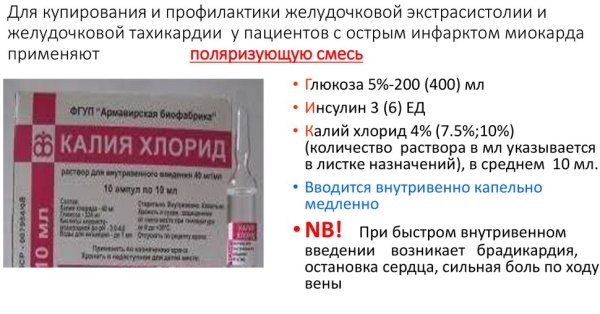
Polarizing mixture
Resuscitators give their patients with traumatic brain injuries or intoxication shock polarizing droppers not with potassium, but with panangin. Sometimes asparkam may be prescribed instead. In this case, glucose is taken at 10%, since its 5% solution can lead to cerebral edema or death.
In intensive care, polarizing drips should include:
- insulin (6-8 units);
- 10% glucose (150 ml);
- panangin or asparkam (up to 80 ml).
For patients in very serious condition with arrhythmia or vascular insufficiency, a mixture of 60 units is infused. insulin and 50% glucose. For those in satisfactory condition 40 units. insulin is dissolved in 18% glucose. Next, patients are supported with a polarizing mixture containing 20 units. insulin and 10% glucose.
Potassium deficiency is calculated according to the following scheme:
K (in mmol) = person's weight (in kg) x 0.2 x 2 x 4.5
As a result, after calculations, we get 4% potassium chloride, which is dissolved up to 500 ml with injection water (1 to 10) or 5% glucose. Severe poisoning requires dissolving 4% potassium in 40% glucose. The usual dose recommended by experts does not exceed 20 mmol of electrolyte per hour or 2-3 mmol of potassium per 1 kg of human weight per day.
The dosage of the polarizing mixture in each specific case may be different. The use of droppers with this drug reduces mortality from cardiovascular diseases by 12%. The composition of a complex drug is often supplemented and adjusted to enhance the therapeutic effect.
Active ingredients of the drug
The mixture in its original form contains:
The composition of the polarizing mixture varies depending on the proportions and type. Some products (varieties of solution) contain a minimal amount of potassium chloride, insulin and glucose solution. In other versions, the medicine contains several grams of potassium chloride, insulin, and a weakly concentrated glucose solution. As you can see, the compositions are similar; they are used to restore heart function. A mixture is produced in which potassium chloride is replaced by Panangin.




